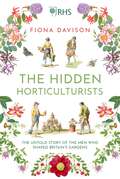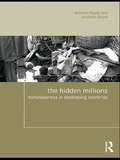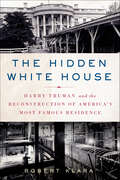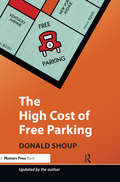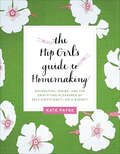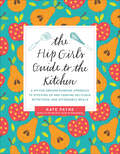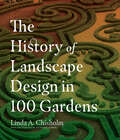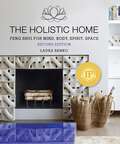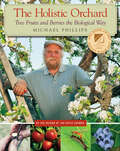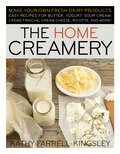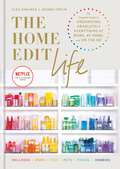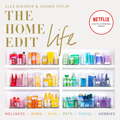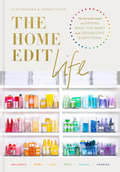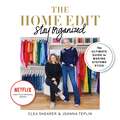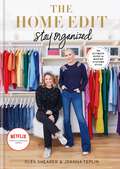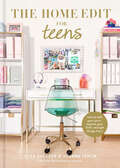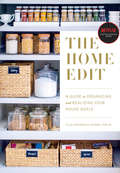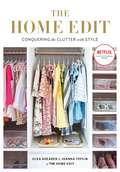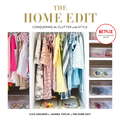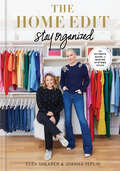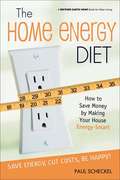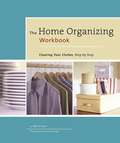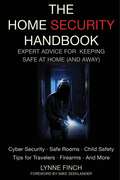- Table View
- List View
The Hidden Horticulturists: The Untold Story of the Men Who Shaped Britain's Gardens
by Fiona DavisonIn 2012, while working at the Royal Horticultural Society's library, Fiona Davison unearthed a book of handwritten notes that dated back to 1822. The notes, each carefully set out in neat copperplate writing, had been written by young gardeners in support of their application to be received into the Society's Garden. Among them was an entry from the young Joseph Paxton, who would go on to become one of Britain's best-known gardeners and architects. But he was far from alone, and now, for the first time, the stories of the young, working-class men who also played a central role in the history of British horticulture can be told. Using their notes, Fiona Davison traces the stories of a selection of these forgotten gardeners whose lives would take divergent paths to create a unique history of gardening. The trail took her from Chiswick to Bolivia and uncovered tales of fraud, scandal and madness—and, of course, a large number of fabulous plants and gardens. This is a celebration of the unsung heroes of horticulture whose achievements reflect a golden moment in British gardening, and continue to influence gardeners today..
The Hidden Millions: Homelessness in Developing Countries (Housing and Society Series)
by Graham Tipple Suzanne SpeakThis book explores the extent, causes and characteristics of homelessness in developing countries. Bringing together a major review of literature and empirical case studies, it is invaluable for those studying, researching or working in housing, homelessness, social policy or urban poverty. Drawing on local research in nine countries in the global south, this book offers an insight into the lives of homeless people, public perceptions of homelessness, and the policies and interventions which might variously increase or reduce homelessness. Exploring the human context as well as policy and planning, it will challenge preconceptions.
The Hidden White House: Harry Truman and the Reconstruction of America's Most Famous Residence
by Robert KlaraThe little-known story of the White House’s gutting and renovation during the Truman presidency: “Delightful and informative . . . plenty of entertaining drama.” —Publishers WeeklyIn 1948, President Harry Truman, enjoying a bath on the White House’s second floor, almost plunged through the ceiling of the Blue Room into a tea party for the Daughters of the American Revolution. A handpicked team of the country’s top architects conducted a secret inspection of the troubled mansion and, after discovering it was in imminent danger of collapse, insisted that the First Family be evicted immediately. What followed would be the most historically significant and politically complex home-improvement job in American history. While the Trumans camped across the street at Blair House, Congress debated whether to bulldoze the White House completely, and the Soviets exploded their first atomic bomb, starting the Cold War.Robert Klara reveals what has, until now, been little understood about this episode: America’s most famous historic home was basically demolished, giving birth to today’s White House. Leaving only the mansion’s facade untouched, workmen gutted everything within, replacing it with a steel frame and a complex labyrinth deep below ground that soon came to include a top-secret nuclear fallout shelter.The story of Truman’s rebuilding of the White House is a snapshot of postwar America and its first Cold War leader, undertaking a job that changed the centerpiece of the country’s national heritage. The job was by no means perfect, but it was remarkable—and, until now, all but forgotten.Includes photographs“Captivating . . . From bathtubs to bomb shelters, Klara leaves no piece of crumbling sandstone unturned and is as astute a storyteller as he is a dogged researcher.” —Denise Kiernan, New York Times–bestselling author of The Last Castle
The High Cost of Free Parking: Updated Edition
by Donald ShoupOne of the American Planning Association’s most popular and influential books is finally in paperback, with a new preface from the author on how thinking about parking has changed since this book was first published. In this no-holds-barred treatise, Donald Shoup argues that free parking has contributed to auto dependence, rapid urban sprawl, extravagant energy use, and a host of other problems. Planners mandate free parking to alleviate congestion but end up distorting transportation choices, debasing urban design, damaging the economy, and degrading the environment. Ubiquitous free parking helps explain why our cities sprawl on a scale fit more for cars than for people, and why American motor vehicles now consume one-eighth of the world's total oil production. But it doesn't have to be this way. Shoup proposes new ways for cities to regulate parking – namely, charge fair market prices for curb parking, use the resulting revenue to pay for services in the neighborhoods that generate it, and remove zoning requirements for off-street parking. Such measures, according to the Yale-trained economist and UCLA planning professor, will make parking easier and driving less necessary. Join the swelling ranks of Shoupistas by picking up this book today. You'll never look at a parking spot the same way again.
The Hip Girl's Guide to Homemaking: Decorating, Dining, and the Gratifying Pleasures of Self-Sufficiency—on a Budget!
by Kate PayneWith The Hip Girl's Guide to Homemaking, it's possible and even convenient to create an inviting space for living and entertaining on a budget. From unique decor ideas to growing strawberries on your fire escape, Kate Payne shares fun, low-cost (and often free!) creative solutions that will make anyone feel more accomplished in minutes.Inside this savvy motivational guide filled to the brim with small-scale creative home projects, Kate's tongue-in-cheek tone will keep you tuned in to her much-needed advice. In three easy sections, you'll learn how to create a comfortable space while being time- and budget-conscious. Section One, Home-ify Your Pad, features quick, convenient ways to make your place cozier with low-cost, special touches to help you tap into and show off your inner artist. Section Two, Impressive Acts of Domesticity, teaches how to impress others (and yourself) with the gratifying pleasures of self-sufficiency—a first-time guide to cleaning, sewing, repairing, and other previously out-of-the-question tasks. Section Three, Life After Restaurants, frees you to release the take-out menu, avoid pricey bar tabs, and entertain others in the space you've so thoughtfully and gorgeously created. User-friendly "how-to" sidebars, illustrations, and tips and tricks throughout the book offer easy-to-follow recipes and do-it-yourself craft suggestions for making your home hip, comfortable, and inviting. Keep in mind that this is not your grandmother's handbook and it's not the kind of wisdom your mom knows how to impart. Modern women need a modern approach to domestic pleasures—a guide to doing household things on our own terms, because most of this stuff isn't as hard as we've been led to believe. Don't worry, she's not asking you to host Tupperware parties or iron your underwear. But as all beginning home keepers know, a sure fire way to feel bad about ourselves is to consult Martha Stewart. So ditch that 2-inch thick handbook, dust off your pots and pans, and join Kate on this journey to incorporating creativity and self-sufficiency on the home front.
The Hip Girl's Guide to the Kitchen: A Hit-the-Ground-Running Approach to Stocking Up and Cooking Delicious, Nutritious, and Affordable Meals
by Kate PayneThe author of The Hip Girl's Guide to Homemaking shows you how to love your kitchen and learn to make creative, delicious food without breaking your budget.You can become a confident cook—even if the drawer with the take-out menus is the only part of your kitchen you currently use! Kate Payne shows you how to master basic cooking techniques—boiling, baking, and sautéing—and simplifies the process of fancy ones, like jamming and preserving, dehydrating, braising, roasting, infusing, and pickling. With this straightforward and fun guide, you can stock up your kitchen with the ingredients, tools, and appliances you'll actually use. You'll also learn how to decode recipes and alter them to make them gluten-free, dairy-free, or vegan. The Hip Girl's Guide to the Kitchen includes advice and instructions on how to make both classic meals and foods that are typically bought, such as yogurt; ice cream; flavored salt; oil and vinegar infusions; kimchi; aioli; jam; granola; bread; and fruit leather—even liqueurs, iced teas, and vegetable juices. With fun line drawings, sidebars full of tips and tricks, and lists of resources, Kate Payne sets you up for success and shows you how to unlock your inner kitchen prowess.
The History of Landscape Design in 100 Gardens
by Linda A. ChisholmThe History of Landscape Design in 100 Gardens explores the defining moments in garden design. Through profiles of 100 of the most influential gardens, Linda Chisholm explores how social, political, and economic influences shaped garden design principles. The book is organized chronologically and by theme, starting with the medieval garden Alhambra and ending with the modern naturalism of the Lurie Garden. Sumptuously illustrated, The History of Landscape Design in 100 Gardens is a comprehensive resource for garden designers and landscape architects, design students, and garden history enthusiasts.
The Holistic Home: Feng Shui for Mind, Body, Spirit, Space
by Laura BenkoRule the world and take control of your emotional and mental health from where you sit, stand, and sleep. The Holistic Home is based on an original lifestyle concept focused on creating a dynamic, healthy, and thoughtful space within yourself and your home by combining three planes of action—mind, body, and spirit—that result in profound change. The condition of the mind affects the psychology of how you dwell: subconscious influences, decorating with intention, and allowing your emotional issues and challenges to manifest in your space. The physical aspects of your design space, such as furniture positioning, design elements, sustainability, wellness, and organization, are representative of your relationship with your body. And finally, the spirit refers to all the invisible energies within you and your home—feng shui, atmosphere, and the soul of your home. Years ago, author and holistic feng shui expert Laura Benko was diagnosed with a rare cancer. Around that time, a book serendipitously fell on her head. She took this as a much-needed sign to devote the next decade of her life to research and hundreds of transformative holistic design consultations. Her clients&’ real-life, inspiring stories, along with specific actions and tips, have become the foundation for The Holistic Home. Chapter by chapter, you&’ll learn how to holistically tackle it all—relationships, clutter, health, communities, inner balance, and more—by looking within your immediate environment to make direct connections in your life.
The Holistic Orchard: Tree Fruits and Berries the Biological Way
by Michael PhillipsWinner of the American Horticulture Society Book Award&“Phillip&’s first-hand knowledge anchors this innovative and highly readable book in practical wisdom that both beginner and long-time fruit growers will find invaluable.&”—Toby Hemenway, author of Gaia&’s GardenMany people want to grow fruit on a small scale but lack the insight to be successful orchardists. As The Holistic Orchard illustrates, growing tree fruits and berries is something virtually anyone can do. A holistic grower knows that producing fruit is not about manipulating nature but more importantly, fostering nature.The Holistic Orchard demystifies the basic skills everybody should know about the orchard ecosystem, focusing on:Orchard designSoil biologyOrganic health managementGraftingPlantingPruningChoosing the right varieties for your climateIncludes a step-by-step instructional calendar to guide growers through the entire orchard year!Fruit profiles include:pome fruits (apples, pears, asian pears, quinces)stone fruits (cherries, peaches, nectarines, apricots, plums)berries (raspberries, blackberries, blueberries, gooseberries, currants, and elderberries)Phillips completely changed the conversation about healthy orcharding with his first bestselling book, The Apple Grower, and now he takes that dialogue even further by exploring:The connections between home orcharding and permacultureThe importance of native pollinatorsPlantings with shade-tolerant berry bushes and other insectary plantsInformation on cover crops and biodiversitySafe, homegrown solutions to pest and disease challengesAll along the way, Phillips&’ expertise and enthusiasm for healthy growing shines through, as does his ability to put the usual horticultural facts into an integrated ecology perspective. With The Holistic Orchard in your hand you have every reason in the world to confidently plant that very first—or next—fruit tree!
The Home Creamery: Make Your Own Fresh Dairy Products; Easy Recipes for Butter, Yogurt, Sour Cream, Creme Fraiche, Cream Cheese, Ricotta, and More!
by Kathy Farrell-KingsleyDiscover how easy it is to make fresh dairy products at home! You don&’t need a commercial kitchen or specialty ingredients to whip up your own cheeses, yogurts, and spreads. With simple step-by-step instructions that don&’t require complicated aging techniques, you can add a wonderful range of tart, sweet, and nutty flavors to your cooking. From fresh buttermilk for mouthwatering pancakes to creamy mozzarella in a refreshing Caprese salad, you&’ll soon enjoy the fresh flavors of your homemade dairy creations.
The Home Edit Life: The Complete Guide to Organizing Absolutely Everything at Work, at Home and On the Go (Home Edit)
by Clea Shearer Joanna TeplinThe New York Times Number One BestsellerA Netflix Original Series.'Move over, Marie Kondo - Clea Shearer and Joanna Teplin are the professional organisers the A-list now let rifle through their drawers.' - Sunday Times StyleClea Shearer and Joanna Teplin are back again to bring both function and beauty to your everyday life. In The Home Edit Life they show you how to contain the chaos when it comes to absolutely everything: your work, travel, kids, pets and more. Because the truth is, you don't have to live like a minimalist to feel happy and calm.The Home Edit mentality is all about embracing your life, whether you're a busy mum, a jetsetter - or both! You simply need to know how to set up a system that works for you so you'll maintain it for the long run. Get to know your organizing style, learn how to tailor it to your habits and, best of all, leave the guilt behind when it comes to owning things. With The Home Edit Life, you'll be corralling cords, archiving photos, packing your suitcase like a pro, and arranging your phone apps by colour in no time.'While the Nashville-based founders of The Home Edit (and its celeb-followed Instagram) may not be able to give you Rachel Zoe's enviable shoe collection, they can give you the tools to get your own into similarly immaculate order - and hey, that's a step in the right direction.' - People
The Home Edit Life: The Complete Guide to Organizing Absolutely Everything at Work, at Home and On the Go, A Netflix Original Series – Season 2 now showing on Netflix (Home Edit)
by Clea Shearer Joanna TeplinThe New York Times Number One BestsellerA Netflix Original Series.'Move over, Marie Kondo - Clea Shearer and Joanna Teplin are the professional organisers the A-list now let rifle through their drawers.' - Sunday Times StyleClea Shearer and Joanna Teplin are back again to bring both function and beauty to your everyday life. In The Home Edit Life they show you how to contain the chaos when it comes to absolutely everything: your work, travel, kids, pets and more. Because the truth is, you don't have to live like a minimalist to feel happy and calm.The Home Edit mentality is all about embracing your life, whether you're a busy mum, a jetsetter - or both! You simply need to know how to set up a system that works for you so you'll maintain it for the long run. Get to know your organizing style, learn how to tailor it to your habits and, best of all, leave the guilt behind when it comes to owning things. With The Home Edit Life, you'll be corralling cords, archiving photos, packing your suitcase like a pro, and arranging your phone apps by colour in no time.'While the Nashville-based founders of The Home Edit (and its celeb-followed Instagram) may not be able to give you Rachel Zoe's enviable shoe collection, they can give you the tools to get your own into similarly immaculate order - and hey, that's a step in the right direction.' - People (p) 2020 Octopus Publishing Group
The Home Edit Life: The No-Guilt Guide to Owning What You Want and Organizing Everything
by Clea Shearer Joanna TeplinThe New York Times bestselling authors of The Home Edit and stars of the Netflix series Get Organized with The Home Edit teach you how to apply their genius, holistic approach to your work life, on-the-go necessities, and technology.At home or on the go, you don't have to live like a minimalist to feel happy and calm. The Home Edit mentality is all about embracing your life—whether you&’re a busy mom, a roommate living with three, or someone who&’s always traveling for work. You just need to know how to set up a system that works for you. In the next phase of the home organizing craze, Clea Shearer and Joanna Teplin go beyond the pantry and bookshelf to show you how to contain the chaos in all aspects of your life, from office space and holiday storage to luggage and pet supplies. Get to know your organizing style, tailor it to your family&’s lifestyle, and lead the low-guilt life as you apply more genius ideas to every aspect of your life.Clea and Joanna are here to remind you that &“it&’s okay to own things&” in the quest for pretty and smart spaces. With The Home Edit Life, you&’ll soon be corralling phone cords, archiving old photos, arranging your phone apps by color, and packing your suitcase like a pro.
The Home Edit Stay Organized: The Ultimate Guide to Making Systems Stick
by Clea Shearer Joanna TeplinJust as The Home Edit Life reassuringly told us that it's OK to own things, Stay Organized promises that it's OK to create a mess. When your systems are working, you'll be able to clean them up within 15 minutes. And as we've all learned over the last few years, maintenance is self-care. Our homes are critical to our mental health. When your systems work, you have more bandwidth. You don't have to start from a maxed-out place. Above all else, move forward feeling calm, collected, and confidently organized -with humor, relatability, and beautiful imagery.Stay Organized covers all kinds of topics related to maintenance, showing readers actionable ways to create systems in their own homes that will be easy to maintain for long-term success. Topics include: - How to get your household on board- Sharing spaces effectively- Household schedules- Maintenance as self-care- Inventory checklists- Checking in with your systems- Staying on top of incoming and outgoing items- Low-bar lifestyle goals for each space(p) 2023 Octopus Publishing Group
The Home Edit Stay Organized: The Ultimate Guide to Making Systems Stick
by Clea Shearer Joanna TeplinJust as The Home Edit Life reassuringly told us that it's OK to own things, Stay Organized promises that it's OK to create a mess. When your systems are working, you'll be able to clean them up within 15 minutes. And as we've all learned over the last few years, maintenance is self-care. Our homes are critical to our mental health. When your systems work, you have more bandwidth. You don't have to start from a maxed-out place. Above all else, move forward feeling calm, collected, and confidently organized -with humor, relatability, and beautiful imagery.Stay Organized covers all kinds of topics related to maintenance, showing readers actionable ways to create systems in their own homes that will be easy to maintain for long-term success. Topics include: - How to get your household on board- Sharing spaces effectively- Household schedules- Maintenance as self-care- Inventory checklists- Checking in with your systems- Staying on top of incoming and outgoing items- Low-bar lifestyle goals for each space
The Home Edit for Teens: How to Edit Your Space, Express Your Style, and Get Things Done!
by Clea Shearer Joanna TeplinThe ultimate guide for getting it together, from lockers and backpacks to bedrooms, closets, and vanities—by the New York Times bestselling authors of The Home Edit.The Home Edit for Teens is a playbook for owning your style, your confidence, your life. Being organized means you&’ll never scramble to find your favorite sweatshirt again and forgetting assignments will be a thing of the past. But the best part of Clea and Joanna&’s signature approach to organizing is that it makes space for you to have fun and enjoy the process. The conclusive guide of tips and advice for the modern teen, this book covers timeless issues such as:• Developing a personalized routine to achieve your goals and carve out more time for fun• Having checklist templates to tick off tasks and goals and keep you on track• Enlisting crates, pouches, baskets, and boxes to help you contain the chaos• Knowing when to toss something that you no longer want or needFull of captivating photography and tips and tricks for every space, The Home Edit is your guide to finding a system that works for your needs and things, including hauls of makeup, hair accessories, or a room full of crafts and books. The best part: you&’ll feel calmer, more confident, and in control of your life.
The Home Edit: A Guide to Organizing and Realizing Your House Goals (Includes Refrigerator Labels)
by Clea Shearer Joanna TeplinThere’s decorating, and then there’s organizing. From the Instagram-sensation home experts (with a serious fan club that includes Reese Witherspoon, Gwyneth Paltrow, and Mindy Kaling), here is an accessible, room-by-room guide to establishing new order in your home.Believe this: every single space in your house has the potential to function efficiently and look great. The mishmash of summer and winter clothes in the closet? Yep. Even the dreaded junk drawer? Consider it done. And the best news: it’s not hard to do—in fact, it's a lot of fun. From the home organizers who made their orderly eye candy the method that everyone swears by comes Joanna and Clea’s signature approach to decluttering. The Home Edit walks you through paring down your belongings in every room, arranging them in a stunning and easy-to-find way (hello, labels!), and maintaining the system so you don't need another do-over in six months. When you're done, you'll not only know exactly where to find things, but you'll also love the way it looks. A masterclass and look book in one, The Home Edit is filled with bright photographs and detailed tips, from placing plastic dishware in a drawer where little hands can reach to categorizing pantry items by color (there's nothing like a little ROYGBIV to soothe the soul). Above all, it's like having your best friends at your side to help you turn the chaos into calm.Featured in Glamour's 10 Books to Help You Live Your Best Life
The Home Edit: Conquering the clutter with style
by Clea Shearer Joanna TeplinThe New York Times BestsellerA Netflix Original Series.What if you could conquer the clutter, make your home pretty and keep it that way?'Move over, Marie Kondo - Clea Shearer and Joanna Teplin are the professional organisers the A-list now let rifle through their drawers.' - Sunday Times Style'Professional organizers Clea Shearer and Joanna Teplin are in high demand in Hollywood, having organized everything from pantries to play rooms for stars like Gwyneth Paltrow, Rachel Zoe, Lauren Conrad and Mandy Moore.While the Nashville-based founders of The Home Edit (and its celeb-followed Instagram) may not be able to give you Rachel Zoe's enviable shoe collection, they can give you the tools to get your own into similarly immaculate order - and hey, that's a step in the right direction.' - People Believe this: every single space in your house has the potential to function efficiently and look great.The mishmash of summer and winter clothes in the closet? Yep. Even the dreaded junk drawer? Consider it done. And the best news: it's not hard to do-in fact, it's a lot of fun.From Clea Shearer and Joanna Teplin, the Instagram-famous home organizers who made their orderly eye candy the method that everyone swears by, comes a signature approach to decluttering. The Home Edit walks you through paring down your belongings in every room, arranging them in a stunning and easy-to-find way (hello, labels!), and maintaining the system so you don't need another do-over in six months. When you're done, you'll not only know exactly where to find things, but you'll also love the way it looks.A master class and lookbook in one, The Home Edit is filled with bright photographs and detailed tips, from placing plastic dishware in a drawer where little hands can reach to categorizing pantry items by color (there's nothing like a little ROYGBIV to soothe the soul). Above all, it's like having your best friends at your side to help you turn the chaos into calm.
The Home Edit: Conquering the clutter with style: A Netflix Original Series – Season 2 now showing on Netflix (Home Edit)
by Clea Shearer Joanna TeplinThe New York Times BestsellerA Netflix Original Series.What if you could conquer the clutter, make your home pretty and keep it that way?'Move over, Marie Kondo - Clea Shearer and Joanna Teplin are the professional organisers the A-list now let rifle through their drawers.' - Sunday Times Style'Professional organizers Clea Shearer and Joanna Teplin are in high demand in Hollywood, having organized everything from pantries to play rooms for stars like Gwyneth Paltrow, Rachel Zoe, Lauren Conrad and Mandy Moore.While the Nashville-based founders of The Home Edit (and its celeb-followed Instagram) may not be able to give you Rachel Zoe's enviable shoe collection, they can give you the tools to get your own into similarly immaculate order - and hey, that's a step in the right direction.' - People Believe this: every single space in your house has the potential to function efficiently and look great.The mishmash of summer and winter clothes in the closet? Yep. Even the dreaded junk drawer? Consider it done. And the best news: it's not hard to do-in fact, it's a lot of fun.From Clea Shearer and Joanna Teplin, the Instagram-famous home organizers who made their orderly eye candy the method that everyone swears by, comes a signature approach to decluttering. The Home Edit walks you through paring down your belongings in every room, arranging them in a stunning and easy-to-find way (hello, labels!), and maintaining the system so you don't need another do-over in six months. When you're done, you'll not only know exactly where to find things, but you'll also love the way it looks.The Home Edit is a master class filled with detailed tips, from placing plastic dishware in a drawer where little hands can reach to categorizing pantry items by color (there's nothing like a little ROYGBIV to soothe the soul). Above all, it's like having your best friends at your side to help you turn the chaos into calm.(p) 2020 Octopus Publishing Group
The Home Edit: The Ultimate Guide to Making Systems Stick
by Clea Shearer Joanna TeplinFrom the authors of The New York Times bestseller The Home Edit and The Home Edit Life and hosts of the Netflix series Get Organized with The Home Edit, comes a guide to the most important phase of getting organized: staying that way.It's one thing to get organized, but how do you make those systems stick? The Home Edit Stay Organized takes the intimidation and hesitation out of the maintenance involved to prevent you from abandoning your once-tidied systems or maybe help you to get organized in the first place!When you have a system that works, maintenance is a breeze. Think of a silverware drawer: It's obvious where each utensil goes, and so everyone in your house should know how to move the forks from the dishwasher to their spot. Often, when you&’re struggling to keep your home tidy, it&’s because your system is too complex and needs some tweaking—and this book will dig deeper to show you how. Throughout the book, Clea and Joanna reveal the important habits, debunk the myths, address the setbacks of being organized, and new and exclusive images show you how to tackle the hardest and trickiest spaces in each room in order to create a home that's organized for the long term. With inventory checklists, tips for getting the whole family on board to help, fans' frequently asked questions, and more, The Home Edit Stay Organized will help you move forward feeling calm, collected, and confidently organized—with humor, relatability, and beautiful imagery to enjoy along the way.
The Home Energy Diet: How to Save Money by Making Your House Energy-Smart (Mother Earth News Books for Wiser Living)
by Paul ScheckelAn energy auditor&’s guide to using less, saving more, and choosing appliances and systems that will make your home healthier and more efficient. Many homeowners are beginning to examine the energy efficiency of their own homes, asking questions about where energy comes from and how much it costs, how to choose new appliances, and what options exist for renewable energy.The Home Energy Diet answers all these questions and more while helping readers take control of their personal energy use and costs so they can save money, live more comfortably, and help the environment. Energy auditor Paul Scheckel first explores energy literacy, and then describes how your home uses—and loses—energy you pay for via electricity, hot water, heating, air conditioning, windows, walls, and insulation. Energy efficiency is an investment that offers returns greater than Wall Street—and readers can potentially earn several hundred dollars every year just by following the advice in this book. As a bonus, many of these strategies, habits, and upgrades can make for improved indoor air quality and healthier, more comfortable homes. &“A valuable resource [with a] humorous and down-to-earth style.&” —Jim Gunshinan, managing editor, Home Energy
The Home Organizing Workbook
by Victoria Pearson Wendi Nordeck Meryl StarrFailing the Mary Poppins' snap-the-fingers approach to cleaning, here's the next best thing: an utterly practical handbook that offers lasting results for anyone looking to banish clutter from every room in the house. Home organizer par excellence Meryl Starr offers up her hardworking organizing solutions in The Home Organizing Workbook, a straightforward guide to getting organized. The room chapters begin with targeted questionnaires that help the reader identify specific organizational problems, followed by hundreds of hardworking solutions and strategic maintenance tips. Those itching to get started can dive right in with step-by-step organizing projects ranging from quick-and-easy weeknight jobs, like overhauling the spice cabinet, to more intensive endeavors such as reorganizing the bedroom closet. Accessory lists at the end of each chapter feature dozens of the best products available, from lazy susans to shelf dividers, and explain exactly how they can be used to optimum effect in each room, while the extensive resource list shows where to get them. Ready to clear that clutter and keep it that way? The Home Organizing Workbook is the ultimate guide to preserving open spaces.
The Home Owner's Manual
by Dan Ramsey Paul Kepple Jude Buffum The Fix-It ClubAt Last! A Beginner's Guide to Home Technology Water stains on your ceiling. Dents and cracks in your drywall. Radiators that hiss and gurgle all night long. It's enough to make you cry out, "Why doesn't my house come with an owner's manual?" And now--finally!--it does. Through step-by-step instructions and helpful schematic diagrams, The Home Owner's Manual explores hundreds of frequently asked questions: What's the best way to fix a leaky faucet? When should I have my chimney cleaned? How can I reset a circuit breaker without electrocuting myself? Whatever your concerns, you'll find the answers here--courtesy of licensed building contractor Dan Ramsey, who has taught the basics of renovation to thousands of homeowners.
The Home Security Handbook: Expert Advice for Keeping Safe at Home (And Away)
by Lynne Finch Mike SeeklanderDo you know what to do if you think someone is in your house? What if an unmarked car is trying to pull you over on a dark and lonely? Author Lynne Finch takes a comprehensive look at ways to improve your family's immediate safety and methods for protecting them in the future. Finch covers a wide range of topics from temporary ways renters can make their home secure, to more permanent changes an owner can make. As well as travel tips for domestic and international travel, with suggestions as simple as how to use your luggage tags to not only make your bag distinct, but to be more security conscious.Through interviews with Law Enforcement officers, Finch provides advice on how to handle various social interactions that keeps you from becoming a victim. These safety suggestions are helpful to readers of all ages, and a must-read for those just going off to college. Learn how to keep your drink safe at a bar or club, and prevent your friend from becoming a target. As well as what to do if someone is following you home at night.Home Security Handbook is a well researched, thoughtful look at a serious subject that affects everyone live's. Written in an approachable, conversational style, Finch provides informative tips that help prepare readers to deal with the most common safety concerns.
The Home Style Handbook
by Lucy Gough'Lucy is one of the most talented stylists I have ever had the privilege to meet. She creates beautiful and imaginative spaces that I want to live in and is always so generous with her knowledge and inspiration. This book will be an invaluable learning tool as well as a treasure for years to come.' Kate Watson-Smyth, @mad_about_the_house'What a wonderful book! Lucy is thoroughly inspiring and has that enviable gift of being able to explain her ideas brilliantly to people who are not as confident as her at design and colour. Lucy has such a natural sense of style and she uses colour in a way that creates such harmonious interiors. This book makes interior design accessible to the uninitiated.' Annie Sloan'Have you ever wondered how to ensure a cohesive feel throughout your home or how to style a neutral interior? Lucy Gough's new book answers these questions - along with the more common dilemmas of choosing art and successfully combining clashing patterns. And, while creating a home that you adore can feel like a daunting task, Lucy breaks it down so it feels less overwhelming ... The homes showcased here are aspirational, characterful and utterly dreamy.' Homes & AntiquesWe all want to live in a home that reflects our personalities and experiences. But if we are not a professional decorator or stylist where do we start? In this inspirational and helpful handbook, interiors stylist and tutor Lucy Gough will teach you how to understand your true style and how to implement it as you decorate your living space. Your dream home needn't be a spacious, architecturally designed building - it could be small or rented - and with this book you'll discover what YOU love so you can surround yourself with the colours, furniture, furnishings and finishing touches that inspire you. The book includes:- How to create and use a moodboard.- How to translate magazine imagery into your home - How to create impact with art, plants and accessories - How to style your kitchen, living room, bathroom, home office and hallway- Key inspirational case studies - explaining how and why they work so well.
